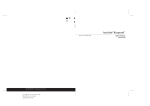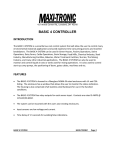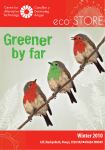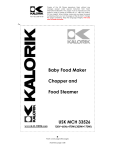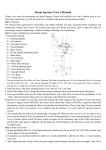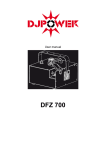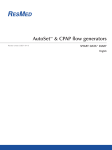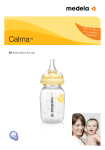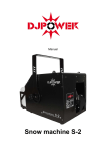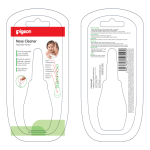Transcript
新母乳実感 能書 サイズ:172 96(mm) 印刷:1C PANTONE Cool Gray 11C Peristaltic PLUS™ Nursing Bottle Caution: Caution: Sterilization Before first use, be sure to clean and place in boiling water for 5 minutes. This is to ensure hygiene. Always wash your hands with soap before cleaning, sterilizing and feeding. • To protect the ventilation valve and cross-cut nipple opening, a white powdered food additive has been applied. Before using for the first time, wash thoroughly. • Use both hands to gently rub clean the ventilation valve, vent, and nipple opening. If you scrub too hard or pull on these, the valve may split, which can cause leaks. • The tip of the nipple is very delicate. When using a brush to clean the nipple, wash very carefully. Be sure to sterilize before every use. Boiling sterilization: Thoroughly wash the nipple, bottle, cap and hood, and place in water. Bring the water to a boil. Sterilize for 5 minutes after the water comes to a boil. Chemical sterilization and microwave sterilization are possible. Use sterilization products made specifically for baby bottles and nipples. Follow the instructions in the user’s manual for these products. With chemical sterilization, the printing on the bottle may fade. Cleaning Immediately after use, rinse in warm water and wash using a Pigeon Liquid Cleanser. Use a sponge brush to wash plastic bottles. Caution: Scrubbing brushes with abrasives, metal scrubbing brushes and abrasive cleansers can damage bottles. Do not use these items when washing bottles. Nipple opening PPSU PP Vent Ventilation valve How to Assemble 1 Hood 2 3 4 Nipple Cap Shield Bottle 4-4 Nihonbashi Hisamatsu-cho, Chuo-ku, Tokyo 103-8480 JAPAN www.pigeon.com Formula Insert the nipple into top of the cap. Warning: See the milk powder package for details on how to prepare formula. 1. Always prepare formula using water that has been boiled. Use boiled water that has been cooled to above 70°C. If the water cools to below 70°C after boiling, do not use it. 2. Follow the instructions for making formula for each milk powder manufacturer. 3. Put the cap, with nipple affixed, on the bottle, and tighten lightly. Without attaching the hood, swirl the bottle slowly. When the powder is completely dissolved, pour in the rest of the hot water. • When preparing formula, if you shake the upright bottle, hot liquid may gush out, causing burns. Handle the bottle carefully. • Do not attach the hood and shake the bottle. If the hood is attached, the high temperatures may cause the pressure inside the bottle to rise, leading to leaks or spouting of the hot liquid. 4. After preparing the formula, attach the hood, and hold the bottle under running tap water until the temperature cools to a degree suitable for feeding. At this time, prevent the running water from coming into contact with the nipple and cap by keeping the water below the cap. Note: Warning: If your baby grows comfortable with one certain nipple, he or she may object if you change to a new one. Rotate the use of 2 or more nipples for about 2 months before replacing them. To prevent the nipples from becoming worn out, replace them earlier if necessary, without regard to how many times they have been used. Follow the warnings below carefully. Not doing so can cause burns. • When preparing formula, the bottle may also become hot. Be careful not to burn yourself. • Do not prepare formula near your baby, as there is a danger of burns. • Be sure to check the temperature of the milk or other fluid before feeding. • After boiling or microwave sterilization, the bottle will be hot. Be careful not to burn yourself. Nursing bottles are to be used to feed your baby milk or other liquids. Do not use them for any other purpose. Grasp the shield firmly. Place over the cap. 5. Drip a little bit of formula on the inside of your arm to check that the temperature is suitable for feeding. M and L size Cross Cut nipples The nipple opening is closed, and milk will not drip out even if you tilt the bottle. After cooling the bottle thoroughly, check the outside temperature of the bottle. SS or S round hole nipples Tilting the bottle may cause milk to gush out. Hold the bottle that way for a while until the flow slows to a slow drip before feeding. Press down firmly Press with your finger to make sure that the ventilation valve opens. Feeding Feed your baby the formula after cooling it to approximately body temperature. Warning: • Only a caregiver should feed the baby. • If you tighten the cap too securely, the nipple may collapse. • After preparing the formula, consume immediately. Discard any formula not used within 2 hours of preparation. Warning: Never use a microwave in the preparation. Microwaves heat unevenly and may cause “hot spots” that could scald the baby’s mouth. For your child’s safety and health WARNING! • Always use this product with adult supervision. • Never use nipples as a soother. • Continuous and prolonged sucking of fluids will cause tooth decay. • Always check food temperature before feeding. • Keep all components out of the reach of children. • Inspect before each use and pull the nipple in all direction. The nipples may be worn by biting. Special attention is needed for teething child. Throw away at the first signs of damage or weakness. • Do not leave a nipple in direct sunlight or heat, or leave in disinfectant (“sterilizing solution”) for longer than recommended, as this may weaken the nipple. • When not in use, keep in a dry, covered container.
